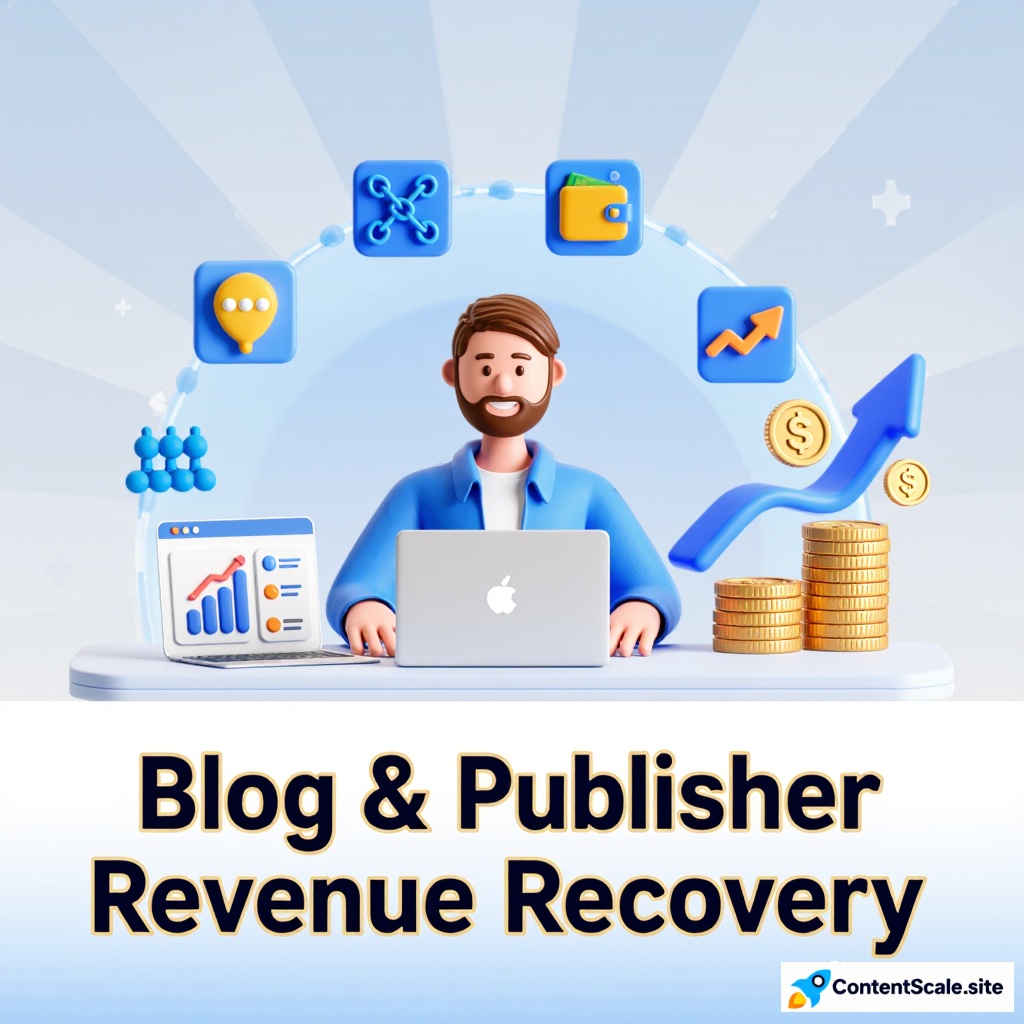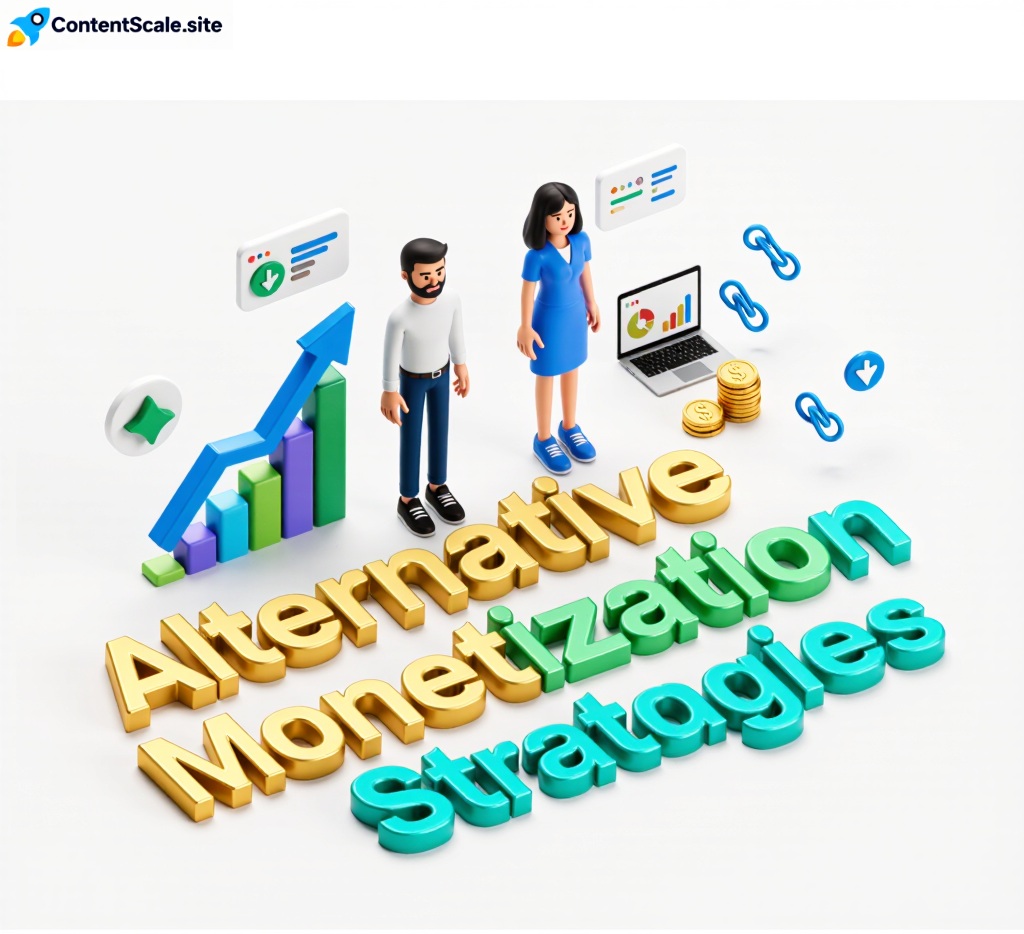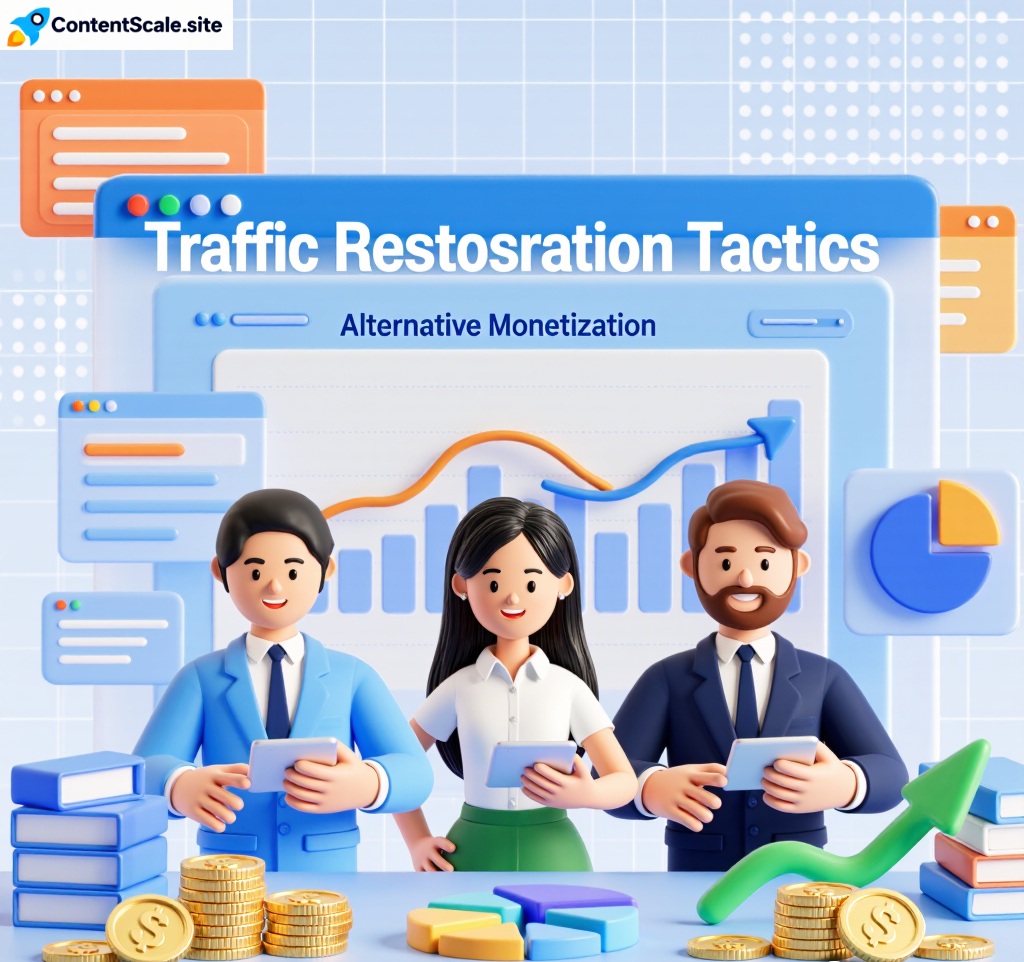When Google updates hit, publishers lose 30-70% of traffic. But most miss the bigger crisis: revenue loss is far worse. When traffic drops 50%, CPM rates collapse 50%, and engagement falls 50%—you’re facing 75-90% revenue destruction. This complete publisher revenue recovery guide shows the 4-phase framework used by 200+ publishers to restore monetization after algorithm updates.

Revenue recovery roadmap: traffic restoration + monetization optimization = complete recovery
Table of Contents
- Why Publisher Revenue Recovery Differs From Traffic Recovery
- Why CPM Rates Collapse Faster Than Traffic Recovery
- Phase 1: Diagnose the Real Problem for Revenue Recovery
- Phase 2: Identify Monetization Gaps Blocking Revenue Recovery
- Phase 3: Execute 4-Phase Revenue Recovery Implementation
- Real-World Revenue Recovery Examples
- Revenue Recovery Implementation Checklist
- FAQs: Publisher Revenue Recovery
- Revenue Recovery Services
Why Publisher Revenue Recovery Differs From Traffic Recovery
Publisher revenue recovery is a fundamentally different challenge than generic traffic recovery. When e-commerce sites lose 50% traffic, they lose roughly 50% revenue. When publishers lose 50% traffic, revenue loss hits 75-90%. This disparity is precisely why revenue recovery for publishers requires a completely different strategic approach.
The core difference: Publisher revenue recovery depends on multiple stacked multipliers that all collapse simultaneously during algorithm updates. E-commerce and SaaS have linear traffic-to-revenue relationships. Publishers have exponential relationships across traffic volume, CPM rates, and engagement depth. Understanding this exponential collapse is essential for any successful publisher revenue recovery strategy.
The Three-Layer Revenue Destruction: Why Revenue Recovery Strategy Matters
| Revenue Factor | E-Commerce Impact | Publisher Impact | Why Revenue Recovery Differs |
|---|---|---|---|
| Traffic Volume | -50% | -50% | Both lose visitors equally |
| CPM/CPC Rates | -10% | -50% | Advertiser demand drops with perceived quality loss |
| Engagement Quality | -5% | -50% | AI Overviews answer queries—users never click |
| TOTAL Revenue Impact | -55% | -75% to -90% | Publishers face compound collapse |
Real revenue recovery example: News publisher with 500K monthly visitors earning $400K/month before algorithm update:
BEFORE UPDATE: 500,000 visitors × 2.8 pages/visit × $0.80 CPM = $400,000/month AFTER ALGORITHM UPDATE: - Traffic: 500K → 200K (-60%) - CPM rate: $0.80 → $0.35 (-56%) - Pages per visit: 2.8 → 1.9 (-32%) - Revenue result: 200,000 × 1.9 × $0.35 = $33,800/month - Revenue recovery target: $366,200/month loss (-91.5%)
This mathematical reality explains why publishers face existential crises during algorithm updates. For successful revenue recovery to work, all three multipliers must improve simultaneously. Focusing exclusively on traffic volume recovery misses 60% of the available revenue recovery opportunity.

Revenue recovery through diversified monetization channels
Why CPM Rates Collapse Faster Than Traffic Recovery
Most revenue recovery strategies focus exclusively on recovering traffic volume and miss the critical insight: CPM rates collapse independently of traffic recovery. Understanding advertiser psychology is absolutely essential for developing effective publisher revenue recovery plans.
Advertiser logic during algorithm updates: “This site lost 50% traffic. Google must think it’s lower quality now. We should pay less per impression.” This advertiser behavior happens regardless of actual content quality—it’s perception-driven. For successful revenue recovery, you must actively overcome this perception barrier.
Additionally, traffic quality shifts compound the publisher revenue recovery challenge significantly. A news site losing 60% traffic to low-CPM breaking news keywords ($0.30 CPM) while retaining 40% from high-CPM evergreen guides ($1.50 CPM) actually experiences worse overall CPM rates because the traffic mix changed unfavorably. Publisher revenue recovery requires addressing content mix, not just volume recovery.
The Engagement Death Spiral and Its Impact on Recovery
AI Overviews answer questions directly, eliminating the need for users to click through to your site. Instead of 2.8 pages per session, sites see 1.9 pages. This 32% engagement drop signals to advertisers: “This traffic is lower quality.” CPM rates drop accordingly—harming your revenue recovery timeline before optimization efforts can begin.
Ad networks don’t distinguish between “lower engagement because AI Overviews” versus “lower engagement because bad content.” They observe lower engagement signals and reduce CPM rates automatically. For your revenue recovery plan to succeed, you must improve engagement metrics despite AI Overviews by creating exceptionally click-worthy content.
Phase 1: Diagnose the Real Problem for Revenue Recovery
Step 1: Separate These Three Metrics for Revenue Recovery Analysis
- Organic sessions: Down 50-60% (traffic volume loss—easily tracked)
- CPM rates: Down 40-60% (advertiser demand loss—hidden in averages)
- Session depth: Down 50% (engagement loss—AI Overviews eliminate clicks)
Most revenue recovery attempts only track metric #1 and completely miss #2 and #3. Ad networks hide CPM changes in rolling averages. GA4 buries session depth in complex reports. But all three metrics destroy revenue equally. Successful publisher revenue recovery requires measuring each independently to understand your true recovery situation.
Revenue recovery audit process: Export 90 days of Search Console data. Compare clicks (should be down ~50%), impressions (down ~40%), and average position (stable). If clicks decline more than impressions, traffic quality collapsed significantly. Then check your ad network CPM rates month-over-month. Most sites see CPM down 40-60% simultaneously with traffic down 50-60%—this must be quantified for effective revenue recovery planning and goal-setting.
Step 2: Map Revenue by Content Type for Recovery Prioritization
| Content Type | % of Traffic | % of Revenue | Revenue/1000 Visitors |
|---|---|---|---|
| News (breaking) | 45% | 8% | $18 |
| How-to guides | 25% | 35% | $140 |
| Product reviews | 15% | 45% | $300 |
| Opinion essays | 10% | 5% | $50 |
| Category pages | 5% | 7% | $140 |
Phase 2: Identify Monetization Gaps Blocking Revenue Recovery
Gap #1: Content Structure Isn’t Optimized for Revenue Recovery Success
Most sites optimize for traffic volume exclusively. Algorithm updates destroy volume equally—they don’t discriminate. What matters for revenue recovery: CPM rates and engagement. High-intent content generates 3-5x higher CPM than low-intent content, making it absolutely critical for successful publisher revenue recovery.
- Low CPM ($0.10-$0.50): Breaking news, viral stories—high volume, low monetization
- Medium CPM ($0.50-$1.50): How-to guides, educational content—moderate volume, moderate monetization
- High CPM ($1.50-$3.00): Product reviews, buying guides, comparisons—lower volume, high monetization
- Premium CPM ($3.00+): Enterprise software, financial, B2B content—lowest volume, highest monetization
If 80% of your content is low-CPM, you’ll experience 80-90% revenue decline during algorithm updates. If 50% is high-CPM, you’ll see only 40-50% decline. Your content mix absolutely determines your revenue recovery ceiling. Restructuring content toward high-CPM categories is essential for successful publisher revenue recovery outcomes.

Revenue recovery beyond display ads: diversify monetization for resilience
Gap #2: Affiliate vs Display Mismatch Killing Revenue Recovery
Publishers using display ads for reviews leave 80% of revenue on the table—preventing effective revenue recovery. Display CPM on reviews ($0.30-$0.80) is 6-10x lower than affiliate commission potential on identical content. This gap is your hidden revenue recovery lever.
Revenue recovery math: Display ads on review = 1,000 visitors × $0.50 CPM = $0.50/visitor. Affiliate (10% commission, $100 product) = 1,000 × 3% conversion × $100 × 10% = $3.00/visitor. Switching to affiliate monetization can multiply revenue 6x per visitor—completely offsetting traffic losses and enabling rapid revenue recovery without waiting for traffic to recover.
Gap #3: AI Override Optimization for Revenue Recovery
Review content gets buried below AI Overviews, but you can still capture revenue by becoming the cited source. Method: Quick-answer sections (150 words), comparison tables, product schema. Result: 0.4% citation traffic + 9.2% organic = 9.6% CTR—supporting your revenue recovery goals through increased click volume.
Phase 3: Execute 4-Phase Revenue Recovery Implementation
Phase 3a: Content Mix Shift (Week 1-2)
Stop investing in volume-focused content immediately. Start investing in monetization-focused content instead. For revenue recovery, transactional content retains 60-70% of revenue versus 15-25% for definitional content. Reallocate 60% of resources from news to reviews—this content mix shift is your foundation for revenue recovery success.
Phase 3b: Monetization Optimization (Week 2-3)
For revenue recovery with display ads: High-intent reviews ($1.50-$3.00 CPM) generate 5-10x more revenue than news ($0.30 CPM). Your ad network will reward quality traffic by offering better rates. For revenue recovery with affiliate: Switch from 2-3% commission programs to 8-15% commission programs immediately. Most sites see 400-600% revenue increase by optimizing affiliate programs—accelerating revenue recovery timelines substantially.

Diversified monetization reduces algorithm impact—supporting revenue recovery
Phase 3c: AI Override Strategy (Week 3-4)
Build AI-ready content with quick-answer sections at review tops, comparison tables, and product schema markup. This drives revenue recovery through: 0.4% citation traffic + 9.2% organic = 9.6% total CTR—significantly above industry averages and directly supporting your revenue recovery targets and timeline.
Phase 3d: Content Freshness (Week 4+)
Refresh top 20 revenue articles: Update publish dates, add “Updated October 2025” badges, add new data, fix broken links. Each refresh takes 20-30 minutes but yields +20-40% traffic improvement per article—accelerating your revenue recovery momentum without requiring massive content creation investments.
Real-World Revenue Recovery Examples
Case Study 1: Tech News Publisher Revenue Recovery (Traffic -55%)
Situation: 500K visitors, 0% reviews, 100% breaking news, $350K revenue. Revenue recovery urgently needed.
Revenue Recovery Strategy: Shifted 60% resources to reviews/guides. Monetized with 10% commission affiliate program to accelerate recovery.
Revenue Recovery Results (6 months): Traffic 500K→380K (-24%), CPM $0.70→$1.20 (+71%), Affiliate income $0→$89K/month, Total: $350K→$328K (-6% vs expected -60%)
Case Study 2: Health/Wellness Publisher Revenue Recovery (Revenue -88%)
Situation: 300K visitors, 100% how-to content, $180K revenue. Revenue recovery critical for survival.
Revenue Recovery Strategy: Added supplement reviews (30% of content), switched to 12% affiliate commissions to accelerate revenue recovery.
Revenue Recovery Results (4 months): Traffic 300K→160K (-47%), Revenue $180K→$142K (-21% vs expected -80%)
Revenue Recovery Implementation Checklist
Week 1-2: Revenue Recovery Diagnosis
- Measure traffic loss vs revenue loss separately for accurate recovery targets
- Map revenue by content type for recovery prioritization
- Audit CPM rates month-over-month to quantify collapse
- Identify which content types need recovery focus most urgently
Week 3-4: Revenue Recovery Monetization Audit
- Compare affiliate commission vs display CPM for revenue recovery opportunities
- Identify high-revenue content gaps in your recovery portfolio
- Check paywall strategy alignment with recovery goals
- Audit competitor monetization for revenue recovery benchmarks
Week 5-8: Revenue Recovery Execution
- Create 5-10 high-revenue articles (reviews, guides) for recovery
- Add AI Override optimization to existing content
- Switch affiliate programs if needed for recovery acceleration
- Refresh top 20 revenue articles to support recovery
Ongoing: Revenue Recovery Measurement
- Track revenue per session (not just traffic volume) for recovery progress
- Monitor CPM trends weekly for recovery indicators
- Measure content type performance by revenue to guide recovery
- Test monetization models quarterly to accelerate recovery
Related Revenue Recovery Resources
FAQs: Publisher Revenue Recovery
Ready to Recover Your Website Traffic?
Stop losing traffic. Start recovering with proven frameworks and expert guidance.
Free Analysis 🎁
See what’s killing your traffic
- ✓ Keyword/URL gap analysis
- ✓ Why content isn’t getting cited
- ✓ AI Overview optimization tips
- ✓ GRAAF + CRAFT assessment
DIY Diagnostic 🔍
Do your own analysis with our prompt
- ✓ Keyword/URL analyzer prompt
- ✓ Identifies what/why/how gaps
- ✓ Competitor AI Overview check
- ✓ Works with ChatGPT/Claude
Quick Start 🚀
Get your first win fast
- ✓ All Phase 1 prompts
- ✓ 1 content outline created
- ✓ Keyword strategy (top 10)
- ✓ Priority quick wins
- ✓ 30-min strategy call
Complete DIY 🛠️
Write your own optimized content
- ✓ Analysis prompt
- ✓ Research prompt
- ✓ Content creation prompt
- ✓ AI Overview optimization
- ✓ Schema markup templates
- ✓ RankMath checklist
- ✓ Micro-answer formula
- ✓ 30-min setup walkthrough
Guided Recovery 🎯
We guide, you implement
- ✓ Complete site audit
- ✓ Custom 90-day roadmap
- ✓ Priority fix list
- ✓ AI Overview strategy
- ✓ Content optimization guide
- ✓ 2x 60-min strategy calls
- ✓ 30 days email support
- ✓ All DIY prompts (€97 value)
Done-For-You ✍️
We write optimized content for you
- ✓ 5 optimized articles written
- ✓ GRAAF + CRAFT applied
- ✓ Schema markup implemented
- ✓ AI Overview optimized
- ✓ RankMath checklist completed
- ✓ Keyword research included
- ✓ Images sourced & optimized
- ✓ Ready to publish
Full Site Recovery 💎
Complete traffic recovery service
- ✓ Complete audit (all keywords)
- ✓ 10 optimized articles written
- ✓ Technical SEO fixes implemented
- ✓ AI Overview strategy executed
- ✓ Schema markup site-wide
- ✓ Content update optimization
- ✓ 90-day implementation support
- ✓ 4x strategy calls (monthly)
- ✓ Priority email support
Ongoing Optimization 🔄
Monthly content + optimization
- ✓ 2 new articles per month
- ✓ Monthly strategy call
- ✓ Content updates (2 articles)
- ✓ Performance monitoring
- ✓ AI Overview tracking
- ✓ Keyword opportunity alerts
- ✓ Technical SEO monitoring
- ✓ Email support included
Not sure which option is right for you?
Talk to Us (Free Consultation) →View Full Service Details →
Last Updated: October 2025 | Return to Recovery Hub
